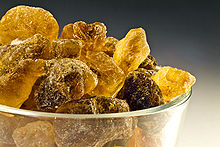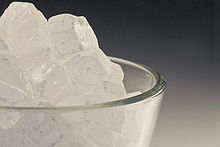Rock candy
 Colored and flavored rock candy commonly sold in the United States | |
| Alternative names | Rock sugar |
|---|---|
| Type | Confectionery |
| Place of origin | Iran |
| Main ingredients | Sugar, water |
| Variations | About 10 |
| 223–400kcal | |
| Other information | 450–225 |


Rock candyorsugarcandy,[1]also calledrock sugar,orcrystal sugar,is a type ofconfectioncomposed of relatively large sugarcrystals.In some parts of the world, local variations are calledMisri,nabat[2]ornavat.[3][4]
This candy is formed by allowing asupersaturatedsolution of sugar and water to crystallize onto a surface suitable for crystalnucleation,such as a string, stick, or plain granulated sugar. Heating the water before adding the sugar allows more sugar to dissolve thus producing larger crystals. Crystals form after six to seven days.Food coloringmay be added to the mixture to produce colored candy.
Nomenclature
[edit]Etymologically, "sugar candy" derives from late 13th century English (in reference to "crystallized sugar" ), from Old Frenchçucre candi(meaning "sugar candy" ), and ultimately from Arabicqandi,from Persianqand( "cane sugar" ), probably fromSanskritkhanda( "piece of sugar)", The sense gradually broadened (especially in the United States) to mean by the late 19th century "anyconfectionhaving sugar as its basis ". In Britain, these are sweets, and" candy "tends to be restricted to sweets made only from boiled sugar and striped in bright colors.[5]
The modern American term "rock candy" (referring to brittle large natural sugar crystals) should not be confused with the British termrock(referring to an amorphous and opaque boiled sugar product, initially hard but then chewy at mouth temperature).[6]
Origins
[edit]Islamic writers in the first half of the 9th century described the production of candy sugar, where crystals were grown through cooling supersaturated sugar solutions.[7]One of the famed makers of rock candy in the Muslim east isHafiz Mustafain 1864 in Istanbul founded during the reign ofSultan Abdulaziz.[8]
According to the production process, rock sugar is divided into two types: single crystal rock sugar and polycrystalline rock sugar.
Cuisine
[edit]Rock candy is often dissolved in tea. It is an important part of thetea cultureofEast Frisia,where a lump of rock sugar is placed at the bottom of the cup. Rock candy consumed with tea is also the most common and popular way of drinking tea in Iran, where it is callednabat;the most popular nabat flavor issaffron.[9][clarification needed]This method of drinking tea can also be found inCentral Asiaasnovvot.
It is a common ingredient in Chinese cooking. In China, it is used to sweetenchrysanthemum tea,as well asCantonese dessert soupsand the liquorbaijiu.Many households have rock candy available to marinate meats, add to stir fry, and to prepare food such as yao shan. In less modern times, rock sugar was a luxury only for the wealthy. Rock candy is also regarded as having medicinal properties, and in some Chinese provinces, it is used as a part oftraditional Chinese medicine.[citation needed]
Rock candy is used a lot in other countries. In Mexico, it is used during theDay of the Deadto make sugar skulls, often highly decorated. Sugar skulls are given to children so they will not fear death; they are also offered to the dead. In theFrieslandprovince of the Netherlands, bits of rock candy are baked in the luxury white breadFryske Sûkerbôle.Rock candy is a common ingredient inTamil cuisine,particularly in the Sri Lankan city ofJaffna.[citation needed]In the US, rock candy comes in many colors and flavors, and is slightly hard to find, due to it being considered old-fashioned.[6]
Misri
[edit] Misri crystals | |
| Type | Rock candy orsweetener |
|---|---|
| Place of origin | IndiaandIran |
Misrirefers to crystallized sugar lumps, and a type of confectionery mineral, which has its origins in India and Iran, also known as rock sugar elsewhere.[10]It is used in India as a type of candy, or used to sweeten milk or tea.[11][12]
Among Indian misri dishes aremishri-mawa(kalakand),[13]mishri-peda,which are more commonly eaten in Northern-Western India,Uttar Pradesh,Delhi, Rajasthan,Punjab,Odisha, Gujarat,North coastal ofAndhra Pradeshand many other states and parts of India.
TheGhantewalaHalwai of Delhi, who started his career by sellingMisri mawain 1790[14]is famous for Misarimawaand sells 40 varieties of sweets made from Misari.[citation needed]
Beverages
[edit]Rock and ryeis a term used both for alcoholic liqueurs and cocktails using rye whiskey and rock candy, as well as for non-alcoholic beverages made in imitation thereof, such as the "Rock & Rye" flavor of soda pop made byFaygo.[15][16]
See also
[edit]- Hard candy
- Konpeitō
- Jaggery,an early form of sugar
References
[edit]- ^Judy Pearsal; Bill Truble, eds. (1996).The Oxford English Reference Dictionary(2nd ed.). Oxford University Press. pp.213.ISBN0-19-860050-X.
- ^"What is Nabat? Understanding the Differences Between Regular Sugar and Persian Sugar Cubes".Sadaf.com.Retrieved7 March2024.
- ^https://www.thefooddictator.com/hirshon-uzbek-spiced-rock-candy-sugar-navat/[bare URL]
- ^"Video: Oriental Sweets: Navat. How Navat is Made in Uzbekistan".www.centralasia-travel.com.Retrieved7 March2024.
- ^"Candy".etymonline.com.Archivedfrom the original on 22 February 2022.Retrieved3 February2018.
- ^abRichardson, Tim (2002).Sweets: A History of Candy.Bloomsbury. p.90.ISBN978-1-58234-229-0.
- ^"SUGAR".Encyclopaedia Iranica.Archivedfrom the original on 2 March 2018.Retrieved2 March2018.
- ^"Hafiz Mustafa: Istanbul confectionery now exporting".Archivedfrom the original on 14 December 2021.Retrieved14 December2021.
- ^"Sweet Tea Persion Style".My Persion Corner.Archivedfrom the original on 28 December 2015.Retrieved15 February2016.
- ^"Glossary: Misri".Tarla Dalal.Archivedfrom the original on 24 June 2016.Retrieved12 June2016.
- ^Dar, Bashir Ahmad (January 1996).Studies in Muslim philosophy and literature.Iqbal Academy Pakistan. p. 168.ISBN978-969-416-054-2.Retrieved9 August2011.
- ^Baden-Powell, Henry (1868).Hand-book of the economic products of the Punjab: with a combined index and glossary of technical vernacular words.Thomason Civil Engineering College Press. pp.307–.Retrieved9 August2011.
- ^"Kalakand".chezshuchi.com.Archivedfrom the original on 23 June 2016.Retrieved12 June2016.
- ^Hardy's Encyclopaedic Guide to Agra, Delhi, Jaipur, and Varanasi.India: Hardy & Ally. 1970.
- ^"This is How to Bring Rock and Rye Back from the Dead".Liquor.com.13 January 2015.Archivedfrom the original on 16 April 2016.Retrieved15 April2016.
- ^Rouch, Lawrence L. (2003).The Vernor's Story: From Gnomes to Now.University of Michigan Press. pp. 34–.ISBN0-472-06697-8.
Further reading
[edit]- Hadi, Saiyid Muhammad (1902).The sugar industry of the United Provinces of Agra and Oudh.Printed by F. Luker at the Government Press.Retrieved9 August2011.
External links
[edit]- "Recipe for rock candy".Exploratorium.edu.– an educational exercise in crystal and candy making (it may vary on however you want to make it).
